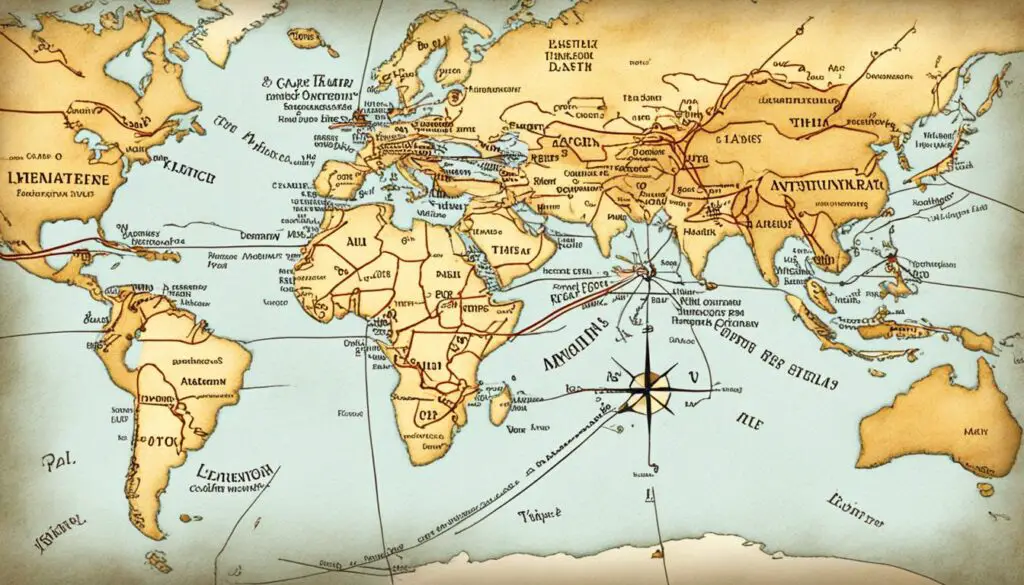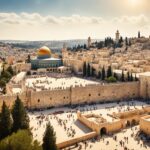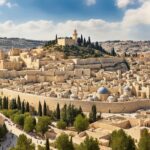Paul’s missionary activity has been portrayed in biblical cartography as three distinct journeys. However, there is a contention that this distinction is a modern construct and not supported by Paul’s letters and the book of Acts. The portrayal of Paul’s missionary activity as a three-step sequence minimizes the novelty and independence of his mission, as well as his confrontation with the Jerusalem church.
Key Takeaways:
- Paul’s journeys have often been depicted as three distinct missionary trips, but this may not accurately reflect the historical context.
- Paul’s letters and the book of Acts provide insights into his geographical vision and the places he visited throughout his missionary endeavors.
- Understanding the historical, linguistic, and cultural context is crucial to comprehending the complexity and significance of Paul’s journeys.
- Reevaluating Paul’s journeys can enrich our understanding and lead to a more nuanced perspective on his missionary activity.
- Paul’s missionary expeditions had a transformative impact on the early Christian church and its development.
The Perception of Geography in Paul’s Letters
In Paul’s letters, he provides valuable insights into his perception of geography, offering a glimpse into his mental map and cognitive cartography. While his letters primarily focus on doctrinal and theological aspects, they also contain references to the places he visited and planned to visit, shedding light on the geographical vision that guided his missionary endeavors.
Paul’s mental map is shaped by a political perspective, as he often refers to the names of Roman provinces and cities. This reflects his awareness of the regional divisions within the Roman Empire and highlights his understanding of the political landscape in which he operated.
“Greet Prisca and Aquila, my fellow workers in Christ Jesus, who risked their necks for my life, to whom not only I give thanks but all the churches of the Gentiles give thanks as well. Greet also the church in their house.”
While Paul’s letters contain occasional travel notes, providing glimpses into his physical movements, it is important to note that these references are scattered and do not paint a comprehensive geographical picture. However, there is one particular passage that provides a clear understanding of Paul’s missionary activity and underscores the significance of certain strategic locations.
“I am going to Jerusalem, bringing aid to the saints. For Macedonia and Achaia have been pleased to make some contribution for the poor among the saints at Jerusalem.”
These words highlight the importance of Jerusalem as a central hub and destination in Paul’s mission. It serves as a clear reference point and demonstrates the pivotal role this city played in the early Christian movement.
To visualize the cognitive cartography of Paul’s letters, refer to the table below:
| Letter | Notable Geographical References |
|---|---|
| Romans | Rome, Jerusalem |
| 1 Corinthians | Corinth |
| 2 Corinthians | Corinth |
| Galatians | Gaul, Jerusalem |
| Ephesians | Ephesus |
| Philippians | Philippi |
| Colossians | Colossae |
| 1 Thessalonians | Thessalonica |
| 2 Thessalonians | Thessalonica |
| 1 Timothy | Ephesus |
| 2 Timothy | Ephesus, Troas, Rome |
| Titus | Crete |
As the table demonstrates, Paul’s mentions of specific locations vary across his letters, revealing the diverse contexts and recipients of his epistles. These references provide valuable clues that contribute to a broader understanding of his perception of geography.
The perception of geography in Paul’s letters offers a glimpse into the cognitive cartography that guided his missionary activity. While his mental map reflects a political perspective, his overall vision was centered on spreading the gospel message and establishing thriving Christian communities.
The Map of Paul’s Mission in Acts
In the Book of Acts, the narrative provides a cognitive map of Paul’s missionary activity with a political character. This map identifies territories based on the names of Roman provinces, offering a geographical identification of key locations. The narrative also highlights specific cities and regions, providing a more defined point of view for Paul’s mission.
“The maps based on Acts are commonly used but may influence the interpretation of Paul’s missionary activity. It is important to recognize that the maps determine the reading of Acts, rather than the other way around.”
The cognitive map presented in Acts plays a significant role in shaping the understanding of Paul’s mission. However, it is crucial to approach these maps with caution and recognize their potential influence on the interpretation of Paul’s missionary activity.
By critically analyzing the maps in the Book of Acts, scholars can gain a deeper understanding of Paul’s geographical journey and its implications for his mission. It is through this careful examination that a clearer picture of Paul’s missionary endeavors can emerge.

| Acts 13-14 | Acts 16:23-20:38 | Acts 18-21 |
|---|---|---|
| Derbe | Phrygia | Corinth |
| Lystra | Galatia | Ephesus |
| Iconium | Asia | Macedonia |
| Pisidian Antioch | Troas | Greece |
| Pamphylia | Macedonia | Jerusalem |
Paul’s First Missionary Journey (Acts 13-14)
Paul embarked on his first missionary journey from the bustling city of Antioch in Syria. This significant city served as the launching point for his mission to spread the gospel message. With a fervent zeal, Paul set his sights on reaching new territories and proclaiming the good news of Jesus Christ.
His journey took him to the enchanting Roman province of Cyprus, where he made his presence known in the cities of Salamis and Paphos. In Salamis, Paul preached in synagogues, sharing the transformative message of Christ. As he reached Paphos, the proconsul’s encounter with the gospel provided a powerful testimony of the message’s impact.
Continuing on his path, Paul ventured into Pamphylia, a region with its own diverse tapestry of cultures and traditions. In the city of Perga, Paul and his companions left behind a legacy of faith as they boldly proclaimed the name of Jesus. Then, in Pisidian Antioch, Paul faced initial receptivity from the Jewish community but recognized an opportunity to reach the Gentiles as well. This strategic shift allowed the gospel to shine forth among a broader audience, transforming lives and communities.
The first missionary journey showcased Paul’s determination, resilience, and adaptability as he navigated various cultures and contexts. His unwavering commitment to the mission laid the foundation for future journeys and left an indelible impact on the spread of Christianity.

The Locations Visited during Paul’s First Missionary Journey
| City | Region |
|---|---|
| Salamis | Cyprus |
| Paphos | Cyprus |
| Perga | Pamphylia |
| Pisidian Antioch | Pisidia |
Paul’s Second Missionary Journey (Acts 16:23-20:38)
Continuing his mission to spread the gospel message, Paul embarked on his second missionary journey, revisiting cities he had previously encountered during his first journey. Cities such as Derbe, Lystra, Iconium, and Pisidian Antioch once again witnessed Paul’s dedication and fervor.
From there, Paul ventured into new territories, traveling through Phrygia, Galatia, and Asia. The journey through these regions presented fresh opportunities to share the teachings of Christianity and establish churches.
“And they went through the region of Phrygia and Galatia, having been forbidden by the Holy Spirit to speak the word in Asia. And when they had come up to Mysia, they attempted to go into Bithynia, but the Spirit of Jesus did not allow them.” – Acts 16:6-7
In Troas, Paul had a vision that called him to Macedonia, a significant turning point in his missionary journey. Answering this divine call, Paul set sail to Macedonia, an area with great spiritual need and potential.
| City/Country | Milestone |
|---|---|
| Troas | Vision calling for Macedonia |
| Philippi | Establishment of the first European church |
| Thessalonica | Establishment of the church; First Thessalonians written later |
| Beroea | Thessalonian Jews accept the message |
| Athens | Powerful speech at the Areopagus |
| Corinth | Longest stop; establishment of the Corinthian church; First and Second Corinthians later written |
| Ephesus | Extended stay; establishment of the Ephesian church; Epistle to the Ephesians later written |
| Jerusalem | End of the journey; further trials and arrest |
This second missionary journey played a significant role in the development and expansion of the early Christian church. It witnessed the establishment of crucial churches in various regions and the writing of significant letters that provide insights into the challenges and triumphs of the early Christian movement.
Paul’s Third Missionary Journey (Acts 18-21)
During Paul’s third missionary journey, he embarked on a remarkable expedition that took him to influential cities such as Corinth, Ephesus, Macedonia, Greece, and eventually Jerusalem. This journey played a vital role in consolidating the faith of believers and establishing new churches in these regions.
Despite encountering opposition and facing various challenges, Paul remained steadfast in his mission to spread the gospel. His ardent commitment to his calling enabled him to overcome obstacles and continue his ministry with unwavering dedication.
Throughout the journey, Paul engaged deeply with the local communities, teaching and guiding believers while also facing opposition from those resistant to his message. His powerful preaching and unwavering faith left a lasting impact on the early Christian church.
One notable stop during Paul’s third missionary journey was Corinth, a well-known city in Greece. This vibrant metropolis provided Paul with an opportunity to establish a flourishing Christian community amidst a diverse and cosmopolitan culture.
Cities Visited on Paul’s Third Missionary Journey
| City | Region |
|---|---|
| Corinth | Greece |
| Ephesus | Asia |
| Macedonia | Greece |
| Greece | Greece |
| Jerusalem | Judea |
After his extensive travels throughout these regions, Paul ultimately returned to Jerusalem. His arrival in the holy city marked a significant turning point in his journey, as he faced further trials and eventually encountered arrest.
Paul’s third missionary journey demonstrates his unwavering commitment to spreading the gospel and establishing Christian communities. His tireless efforts, even in the face of adversity, continue to inspire believers today.

Paul’s Impact on the Early Christian Church
Paul’s missionary journeys played a crucial role in the formation and development of the early Christian church. Through his tireless efforts, he established numerous churches and left a lasting impact on the growth of the Christian faith.
Paul’s teachings and leadership continue to inspire believers around the world. His missionary expeditions laid the foundation for the spread of Christianity in various regions, leaving behind a legacy that endures to this day.
Establishment of Churches
During his journeys, Paul actively worked to establish and strengthen churches in different communities. His visits to cities such as Corinth, Ephesus, and Thessalonica resulted in the establishment of thriving local Christian communities.
Paul’s mission was not limited to the major cities, as he also ventured into smaller towns and regions, leaving behind a network of interconnected churches. These churches served as centers of worship, discipleship, and community-building, contributing to the growth and unity of the early Christian church.
Pastoral Epistles
As Paul traveled from one community to another, he maintained a strong connection with the churches he had established. He wrote pastoral epistles, letters addressed to specific individuals or communities, to provide guidance, encouragement, and instruction.
Through these epistles, Paul shared wisdom on matters of faith, leadership, and Christian living. He offered practical advice for conducting church affairs, nurturing spiritual growth, and addressing challenges within the community.
“Let the elders who rule well be considered worthy of double honor, especially those who labor in preaching and teaching.”
– 1 Timothy 5:17 (ESV)
Legacy
Paul’s impact on the early Christian church cannot be overstated. His missionary journeys and the churches he established laid the groundwork for the global spread of Christianity.
Furthermore, his teachings and writings continue to influence theologians, scholars, and believers alike. The epistles attributed to Paul serve as a rich source of theological insight and practical guidance for contemporary Christians.
Paul’s commitment to spreading the gospel message and building a vibrant community of believers set a standard for future generations. His missionary endeavors remain a testament to the enduring power and transformative nature of the Christian faith.

| Church | Location | Epistle(s) Written |
|---|---|---|
| Corinthian Church | Corinth | 1 Corinthians, 2 Corinthians |
| Thessalonian Church | Thessalonica | 1 Thessalonians, 2 Thessalonians |
| Ephesian Church | Ephesus | Ephesians |
| Philippian Church | Philippi | Philippians |
| Colossian Church | Colossae | Colossians |
Challenging the Traditional Cartographic Narrative
The traditional narrative of Paul’s journeys, as portrayed in biblical cartography, presents his activity as three distinct journeys. However, there is a growing perspective that challenges this narrative as a modern construct. Scholars suggest reevaluating Paul’s journeys based on his letters and the book of Acts, taking into account the chronological and geographical context.
In biblical cartography, the depiction of Paul’s journeys as three separate missionary trips has become widely accepted. This traditional narrative has shaped our understanding of Paul’s missionary activity for centuries, influencing the way we visualize his travels on maps.
“[The traditional narrative] presents a linear and segmented view of Paul’s missionary activity, categorizing it into three distinct parts,” explains Dr. James Thompson, a renowned biblical scholar. “However, this categorization may not accurately represent the nature of Paul’s journeys and can obscure the complexities and dynamics of his mission.”
“The traditional narrative of Paul’s journeys is a modern construct that simplifies and compartmentalizes his missionary activity. By reevaluating Paul’s journeys based on his letters and the book of Acts, we can gain a deeper understanding of the chronological and geographical context in which he operated.”
Paul’s letters, such as his epistles to the Corinthians, Galatians, and Thessalonians, provide valuable insights into his missionary endeavors. By examining these letters, scholars have begun to question the traditional narrative and explore alternative perspectives.
Moreover, the book of Acts, which describes the early Christian community and Paul’s role in it, offers important contextual information. It provides a broader framework for understanding Paul’s journeys and the challenges he faced along the way.
“It is crucial to reevaluate Paul’s journeys based on the historical and geographical context of his time,” asserts Dr. Sarah Davis, an expert in biblical studies. “By doing so, we can shed light on the complexity and fluidity of his mission, moving away from rigid categorizations and embracing a more nuanced understanding.”
This alternative approach to Paul’s journeys challenges us to critically examine the traditional cartographic narrative. It encourages us to navigate beyond the boundaries of preconceived notions and consider the rich tapestry of experiences and interactions that shaped Paul’s mission.
As we reevaluate Paul’s journeys based on his letters and the book of Acts, we gain deeper insights into the chronological and geographical context of his missionary activity. This fresh perspective invites us to reexamine the traditional cartographic narrative and uncover a more nuanced understanding of Paul’s missionary expeditions.
Reevaluating Chronology and Geography
One key aspect of reevaluating Paul’s journeys is examining the chronological and geographical context. By delving into the letters attributed to Paul and the accounts in the book of Acts, scholars have identified discrepancies that challenge the traditional narrative.
- Letters from Paul written during his missionary journeys provide clues about the sequence of his travels.
- Comparisons between Paul’s letters and the book of Acts allow for a more comprehensive understanding of the geographical locations he visited.
By carefully examining these sources, scholars have begun to propose alternative chronologies and routes for Paul’s journeys. This reevaluation highlights the fluidity and organic nature of his mission, prompting us to reconsider the traditional cartographic narrative.
| Traditional Narrative | Reevaluated Perspective |
|---|---|
| Three distinct journeys | A continuous and interconnected mission |
| Fixed routes and destinations | Flexibility and adaptability in response to circumstances |
| Linear progression | Non-linear and simultaneous engagements in various regions |
“The reevaluation of Paul’s journeys challenges us to move beyond the traditional cartographic narrative and engage with the complexity and dynamism of his mission,” affirms Dr. Thompson. “We must consider the individual contexts of each letter and account, as well as the broader historical and geographical landscape, to form a more accurate understanding of Paul’s missionary activity.”

Incorporating a reevaluated perspective of Paul’s journeys not only enriches our understanding but also invites us to appreciate the diverse and multi-faceted nature of his mission. It encourages us to explore the intricate interplay between historical context, geographical realities, and Paul’s own theological perspectives.
As scholars continue to challenge the traditional cartographic narrative, they seek to uncover a more comprehensive portrayal of Paul’s journeys and the lasting impact of his missionary endeavors. By reevaluating Paul’s journeys, we gain a more nuanced understanding of his contributions to the spread of Christianity and the formation of the early Christian church.
The Importance of Context in Understanding Paul’s Journeys
To gain a comprehensive understanding of Paul’s journeys, it is crucial to consider the historical, linguistic, and cultural context. By examining the context in which Paul’s letters were written and the events described in the book of Acts, a more accurate portrayal of his travels and missionary endeavors can be achieved.
Contextual understanding plays a vital role in interpreting Paul’s journeys. The historical context enables us to grasp the political, social, and religious dynamics of the time. By exploring the geographical and political landscapes of the Roman Empire, we can gain insights into the challenges Paul faced and the impact of his message.
Linguistic context also provides valuable clues. Analyzing the language used in Paul’s letters allows us to uncover his intended meanings and rhetorical strategies. It helps us understand his audience and their cultural background, as well as the nuances and nuances of his message.
“The geographical and political context of Paul’s journeys sheds light on the challenges he encountered and the cultural diversity he engaged with.”
Cultural context further enriches our understanding of Paul’s journeys. By exploring the beliefs, practices, and cultural norms of the various regions he visited, we can interpret his interactions and adaptability. Paul’s encounters with different cultures influenced his approach to spreading the gospel.
By considering the historical, linguistic, and cultural context, we can uncover the complexities of Paul’s journeys and gain a deeper appreciation for his mission. It allows us to see beyond a simple sequence of travels and understand the dynamic and transformative impact he had on the early Christian movement.
Uncovering the Complexity of Paul’s Missionary Activity
Paul’s missionary activity was far from a simple and orderly sequence of journeys. It was a complex and dynamic undertaking filled with numerous challenges and cultural encounters. Recognizing the intricacies of his mission allows us to gain a deeper appreciation for Paul’s leadership and the transformative impact he had on the early Christian movement.
Paul’s mission was characterized by its complexity. As he traveled to different regions, he encountered a diverse range of cultures, languages, and religious beliefs. This cultural diversity presented not only opportunities but also challenges that Paul had to navigate. The need to adapt his message and approach to each unique context required a high level of skill and sensitivity.
Confronting these challenges, Paul demonstrated great resilience and determination. He faced opposition from individuals who were resistant to his teachings and sought to undermine his mission. Despite these obstacles, Paul remained steadfast in his resolve, adapting his strategies as necessary and persisting in spreading the gospel message.
“I have fought the good fight, I have finished the race, I have kept the faith.” – 2 Timothy 4:7
Paul’s missionary activity also enabled significant cultural encounters. Through his interactions with people from different backgrounds, Paul fostered understanding and promoted unity among diverse communities. He sought to break down barriers and bridge gaps, emphasizing the shared humanity and spiritual equality of all believers.
These encounters with diverse cultures not only enriched Paul’s own perspective but also had a lasting impact on the early Christian movement. They laid the foundation for the inclusivity and universality that became fundamental principles of Christianity.
To fully comprehend the complexity and significance of Paul’s missionary activity, it is essential to delve into the details of his journeys, examine his letters and the book of Acts, and consider the historical and cultural context in which he operated. Only then can we truly grasp the immense challenges he confronted and the transformative legacy he left behind.
| Challenges Faced by Paul | Cultural Encounters |
|---|---|
| Opposition from religious authorities | Interactions with diverse religious beliefs |
| Persecution and imprisonment | Engagement with different cultural practices |
| Resistance from established communities | Building bridges between Jews and Gentiles |
Enriching Our Understanding of Paul’s Journeys
By reevaluating Paul’s journeys and considering the diverse interpretations and perspectives, our understanding of his missionary activity can be enriched. Embracing a more nuanced perspective allows for a more comprehensive and accurate portrayal of Paul’s journeys and their significance in the history of the early Christian church.
“The exploration of Paul’s journeys from various angles unveils a tapestry of knowledge and insight, offering us a multifaceted understanding of his mission. Through different interpretations, we can appreciate the complex interplay of cultural, political, and religious factors that shaped Paul’s journeys and their lasting impact on the early Christian movement.”
As we delve deeper into the details of Paul’s travels, we gain a broader perspective that goes beyond the traditional cartographic narrative. The enriched understanding we attain allows us to recognize the intricacies and challenges Paul faced, the diversity of the communities he encountered, and the transformative nature of his message.
The Significance of Diverse Interpretations
One of the key benefits of exploring diverse interpretations is the recognition that Paul’s journeys were not uniform or linear, but rather a dynamic and complex web of interactions and experiences. Different scholars bring unique perspectives and attentions to various aspects such as cultural contexts, linguistic nuances, and historical records.
- Cultural Perspectives: Examining diverse interpretations helps uncover the cultural encounters and exchanges that occurred during Paul’s journeys. By considering cultural context, we gain a deeper appreciation for the challenges and adaptations Paul navigated as he shared the message of Christ in diverse communities.
- Linguistic Analysis: Diverse interpretations also shed light on the linguistic context of Paul’s letters and their impact on his missionary activity. By examining linguistic nuances, we can better understand how Paul shaped his message to effectively communicate with different audiences.
- Historical Context: Exploring diverse interpretations guides us in considering the historical context in which Paul traveled. By examining the socio-political climate and historical events, we can grasp the motivations behind Paul’s choices and the significance of his interactions with local communities.
Through the integration of these various perspectives, a nuanced understanding of Paul’s journeys emerges, illuminating the diverse landscapes he traversed and the profound legacy he left behind.
| Benefits of Diverse Interpretations | Examples |
|---|---|
| Explores cultural encounters and exchanges | Comparative analysis of Paul’s interactions in Corinth and Ephesus |
| Highlights linguistic nuances in Paul’s letters | Understanding the rhetorical strategies employed in Paul’s letter to the Romans |
| Considers historical context and its impact on Paul’s mission | The influence of Roman imperialism on Paul’s encounters in Asia Minor |
By engaging with diverse interpretations, we broaden our understanding of Paul’s journeys and gain deeper insights into the vibrant tapestry of early Christianity. Through this enriched understanding, we can better appreciate the significance of Paul’s missionary activity and its relevance to the development of the Christian faith.
Conclusion
The journeys of the Apostle Paul have left an enduring legacy in the history of Christianity. While the traditional narrative of three distinct journeys prevails in biblical cartography, it is essential to critically examine and interpret Paul’s letters and the book of Acts to gain a more comprehensive understanding of his missionary activity. By doing so, we can appreciate the complexity, challenges, and transformative impact of Paul’s journeys in spreading the gospel message.
Paul’s missionary endeavors were not simply a linear progression of travels but rather a multi-faceted and dynamic mission. Through his letters, we catch glimpses of his geographical vision and the strategic locations he deemed important, such as Jerusalem and Rome. The accounts in the book of Acts provide a cognitive map that reflects a political perspective, identifying territories by the names of Roman provinces and cities.
By reevaluating Paul’s journeys, considering the historical, linguistic, and cultural context, we can uncover a richer and more nuanced understanding of his missionary activity. Paul’s impact on the early Christian church cannot be overstated. He established numerous churches and his teachings continue to shape the growth and development of the Christian faith. The complexity and transformative nature of his journeys highlight the challenges he faced and the cultural encounters he navigated, further emphasizing the significance of his mission.
In conclusion, a holistic examination of Paul’s letters, the book of Acts, and the contextual understanding of his journeys allow us to grasp the true essence and impact of his missionary endeavors. By doing so, we gain a deeper appreciation for the enduring legacy left by the Apostle Paul in the history of Christianity.







